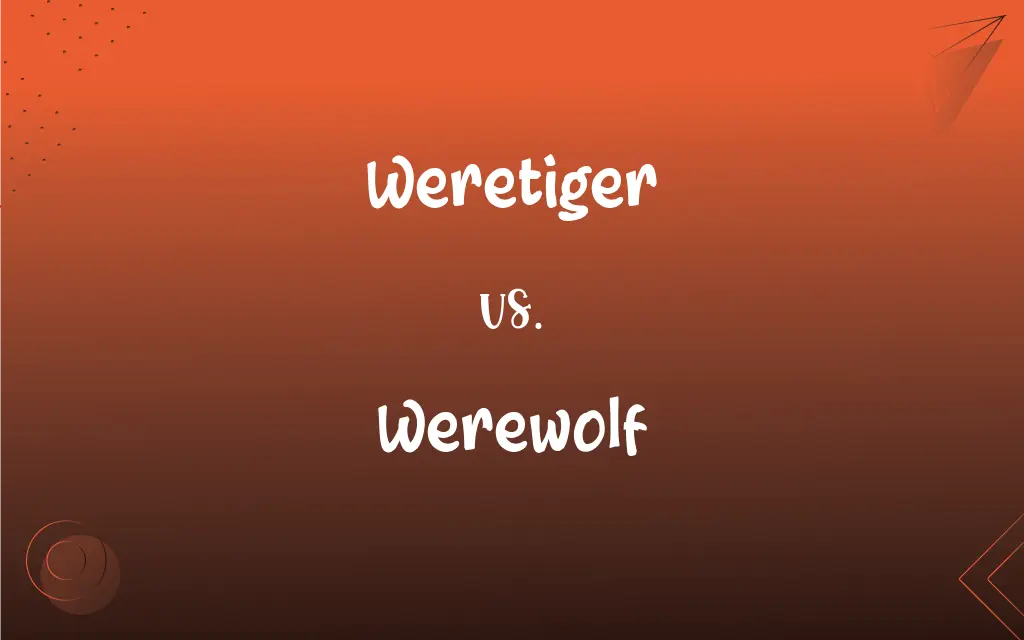Weretiger vs. Werewolf: What's the Difference?
Edited by Aimie Carlson || By Janet White || Updated on September 27, 2023
A "Weretiger" is a mythical creature that can shift between human and tiger forms, while a "Werewolf" is a legendary being that transforms between human and wolf forms.

Key Differences
"Weretiger" and "Werewolf" are both terms that root in folklore and describe humanoids with the ability to change into specific animals. "Weretigers" denote beings with the power to morph into tigers or a hybrid form of humans and tigers. This concept predominantly finds its origins in Asian and especially Southeast Asian mythologies. On the contrary, the term "Werewolf" signifies individuals who can become wolves or humanoid wolves. This notion is extensively prevalent in European folklore and has been a significant element in Western literature and films.
"Weretigers" embody different characteristics based on regional myths. In some cultures, they might be seen as protectors or revered entities, while in others, they can be feared as malevolent spirits. The transformation might be attributed to curses, possession, or even genetic lineage. "Werewolves", in many tales, undergo their metamorphosis during a full moon, often due to a curse or bite from another werewolf. Their portrayal ranges from tragic figures cursed against their will, to ferocious beasts reveling in their primal instincts.
The cultural significance of "Weretigers" and "Werewolves" also varies. In regions where tigers are native and venerated, like India or Indonesia, tales of "Weretigers" often have deep spiritual or moral undertones. These stories might highlight the bond between nature and humans or serve as warnings. In contrast, "Werewolf" legends in Europe, especially during the medieval period, often aligned with fears of the unknown, the wilderness, or the bestial side of humanity. They have often been used as cautionary tales about the dangers of unchecked rage or desires.
While both "Weretigers" and "Werewolves" represent the blending of the human and the animalistic, their stories, attributes, and cultural contexts differ. Whether seen as protectors, monsters, or tragic figures, they stand as testaments to humanity's enduring fascination with the animal kingdom and the boundaries of our own nature.
Comparison Chart
Basic Definition
A being that can transform into a tiger or hybrid form.
A creature that can shift into a wolf or hybrid shape.
ADVERTISEMENT
Cultural Origins
Primarily Asian, especially Southeast Asian mythologies.
Predominantly European folklore.
Causes of Transformation
Curses, possession, genetic lineage, etc.
Bites, curses, full moon, etc.
Common Portrayal
Varies from protectors to feared spirits.
Often seen as cursed beings or ferocious monsters.
Symbolic Interpretation
Bond between humans and nature, spiritual significance.
Fears of the unknown, the wild, or primal human instincts.
Weretiger and Werewolf Definitions
Weretiger
A mythical humanoid that can shift into a tiger.
Legends speak of a weretiger that guards the ancient temple.
ADVERTISEMENT
Werewolf
A legendary creature that can morph into a wolf.
During full moons, he became a werewolf, feared by all.
Weretiger
A being with both human and tiger characteristics.
The villagers spoke of a weretiger that roamed the forests.
Werewolf
A person transformed into a wolf or wolf-like entity.
Bitten by a rogue werewolf, she now bore the curse.
Weretiger
A representation of human-animal spiritual connection in some cultures.
The weretiger in their culture symbolized the deep bond between man and nature.
Werewolf
An embodiment of humanity's primal and ferocious side.
His anger was so wild, it was as if a werewolf lurked within.
Weretiger
A person cursed or gifted to become a tiger.
Under the full moon, he transformed into a weretiger.
Werewolf
A popular figure in European myths known for wolf transformations.
Ancient scrolls depicted tales of werewolves terrorizing villages.
Weretiger
A legend from Southeast Asian folklore about tiger transformations.
In her story, a noble warrior became a weretiger to save his kingdom.
Werewolf
A character often portrayed as either a monster or tragic figure due to its transformation.
In the film, the werewolf was a symbol of inner battles and turmoil.
Weretiger
A creature of Southeast Asian myth; a shapeshifter who can assume the shape of a tiger.
Werewolf
A person believed to have been transformed into a wolf or to be capable of assuming the form of a wolf.
Werewolf
(mythology) A person who is transformed or can transform into a wolf or a wolflike human, often said to transform during a full moon. Category:en:Horror
Werewolf
A person transformed into a wolf in form and appetite, either temporarily or permanently, whether by supernatural influences, by witchcraft, or voluntarily; a lycanthrope. Belief in werewolves, formerly general, is not now extinct.
The werwolf went about his prey.
The brutes that wear our form and face,The werewolves of the human race.
Werewolf
A monster able to change appearance from human to wolf
FAQs
Can a "Werewolf" transformation be reversed?
In some tales, yes, through various remedies or cures.
Where did the idea of "Weretigers" originate?
Predominantly from Asian, especially Southeast Asian mythologies.
Is the "Weretiger" concept similar to the "Werewolf"?
While both involve human-animal transformations, weretigers become tigers, while werewolves become wolves.
Are "Weretigers" always seen as evil in myths?
No, their portrayal varies from protectors to malevolent spirits depending on the culture.
What triggers a "Werewolf" transformation in most stories?
Often, the full moon, a bite, or a curse causes the transformation.
Is the "Weretiger" concept common in popular culture?
While known, it's less common than the werewolf, especially in Western media.
About Author
Written by
Janet WhiteJanet White has been an esteemed writer and blogger for Difference Wiki. Holding a Master's degree in Science and Medical Journalism from the prestigious Boston University, she has consistently demonstrated her expertise and passion for her field. When she's not immersed in her work, Janet relishes her time exercising, delving into a good book, and cherishing moments with friends and family.
Edited by
Aimie CarlsonAimie Carlson, holding a master's degree in English literature, is a fervent English language enthusiast. She lends her writing talents to Difference Wiki, a prominent website that specializes in comparisons, offering readers insightful analyses that both captivate and inform.































































